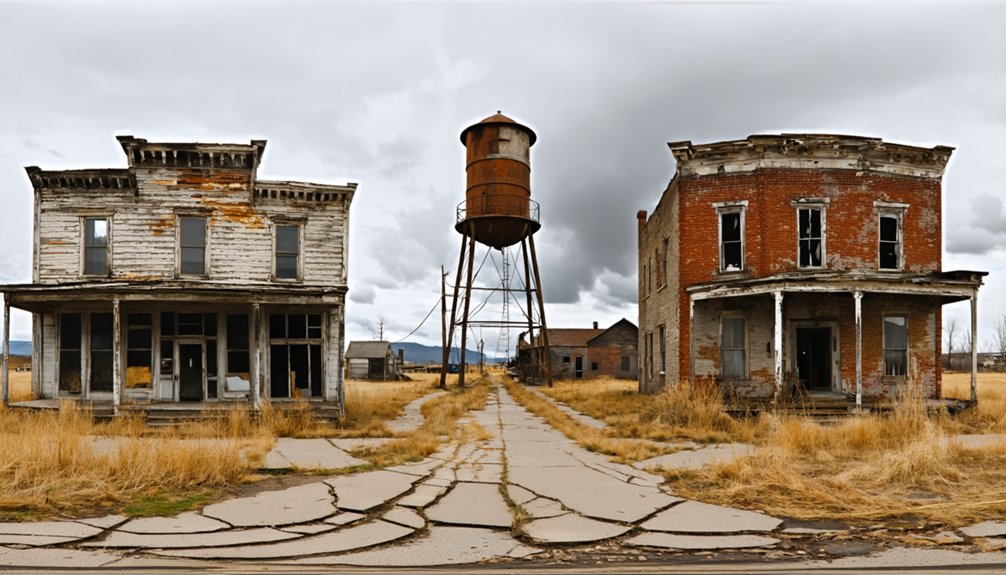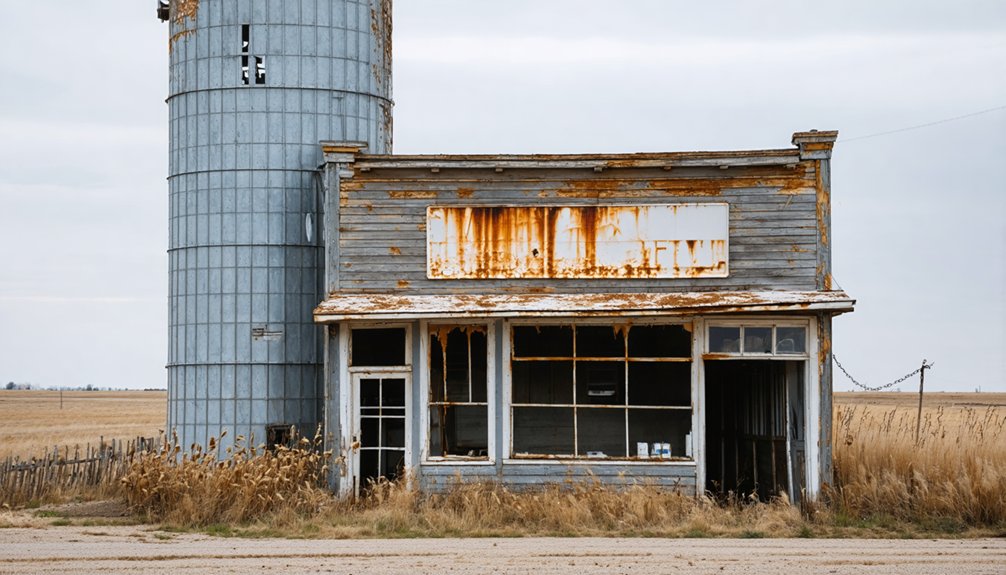The Midwest’s most haunting abandoned sites include Old Joliet Prison in Illinois, where infamous criminals were once incarcerated behind limestone walls now open for paranormal tours. In Nebraska, St. Deroin’s ghostly remnants tell the story of a once-thriving river settlement claimed by floods in 1915. Michigan’s Central Mine showcases copper boom-era houses and a church where descendants still gather annually. These time capsules offer more than just empty buildings—they’re portals to America’s forgotten chapters.
Key Takeaways
- Old Joliet Prison in Illinois offers guided ghost tours through its historic cellblocks built in 1858.
- St. Deroin, Nebraska preserves remnants of an 1854 ferry community with only a schoolhouse and cemetery remaining.
- Central Mine, Michigan showcases 13 preserved houses and a church from a once-thriving copper mining community.
- These Midwest ghost towns combine authentic historical structures with compelling stories of decline and abandonment.
- Annual events like Central Mine’s reunions provide visitors opportunities to connect with the living history of these sites.
Old Joliet Prison: A Haunting Piece of Illinois History
Limestone walls cast long shadows across the Illinois landscape where the Joliet Correctional Center first opened its imposing gates on May 22, 1858.
You’ll find rich prison history in every corner of this gothic structure, built by the very inmates who’d serve time within its confines. For nearly 150 years, the facility housed infamous criminals like John Wayne Gacy and Baby Face Nelson before finally closing in 2002.
Today, you can explore this abandoned fortress through guided tours, including those focused on its reputation for ghostly encounters. The prison was the site of controversial hepatitis experiments conducted on inmates by the US Army during the late 1960s.
Paranormal enthusiasts flock here to investigate one of the world’s most haunted locations, where singing spirits and unexplained phenomena await.
Once left to decay after closure, the prison gained National Register status in 2023 and now stands as a hauntingly preserved piece of American history. Visitors can walk through the empty cell blocks and corridors where notorious criminals once lived their daily lives.
St. Deroin: Nebraska’s Vanished River Settlement
While Illinois preserves its prison history, Nebraska’s forgotten waterways tell tales of another kind of abandonment. Tucked within Indian Cave State Park lies St. Deroin, a once-thriving ferry hub established in 1854 by Joseph Deroin, son of a French trapper and Otoe woman.
You’ll find this settlement was built to serve the mixed-heritage residents of the Nemaha Half-Breed Reservation. By 1915, devastating river floods had changed the Missouri’s course, leaving the ferry landing useless. Just five years later, St. Deroin stood empty.
Today, only the relocated schoolhouse and cemetery remain as silent witnesses to this vanished community. Visitors can explore these historical remnants while enjoying the park’s scenic wooden boardwalks. The town once reached its peak with a population of 300 in the 1870s before its gradual decline. Local ghost stories claim Deroin still rides his buried horse near the graveyard, while one-armed A.J. Ritter supposedly searches endlessly for his missing limb on moonless nights.
Central, Michigan: Where Mining Memories Live On
In the shadow of ancient copper pits, Central Mine rose as one of Michigan’s most spectacular mining success stories, transforming from a speculative venture to a profitable operation within its first year of existence.
When you visit today, you’ll find just 13 houses and a Methodist church where 1,200 residents once thrived. The mine extracted an impressive 52 million pounds of copper before closing in 1898, leaving behind a ghost town that perfectly captures Michigan’s copper heritage. The town’s rapid abandonment followed the copper price collapse, forcing residents to seek economic opportunities elsewhere.
Each July, descendants gather at the church for reunions, keeping connections to this vanished community alive.
As you explore the moss-covered ruins and interpretive displays, you’ll experience the juxtaposition of indigenous mining history with industrial development. The tragic cable break at Shaft No. 2 in 1872 claimed ten miners’ lives, a somber reminder of the dangers that mining communities faced.
Central Mine offers ghost town tourism at its most authentic—where nature reclaims human ambition amid the quiet hills of Michigan’s Keweenaw Peninsula.
Frequently Asked Questions
Are Children Allowed on Ghost Town Tours?
Yes, you’ll find many family-friendly tours that welcome children, though some require minimum ages of 6-10. Always prioritize ghost town safety by supervising kids and choosing age-appropriate experiences.
What’s the Best Season to Visit Midwest Ghost Towns?
Like Thoreau finding solace at Walden Pond, you’ll discover late summer through early fall offers the perfect balance—summer exploration opportunities with long daylight hours shifting to breathtaking autumn colors that transform these forgotten places.
Can You Camp Overnight at Any of These Locations?
You’ll need to check camping regulations for each location. Most require landowner permission or overnight permits, while others prohibit camping entirely to protect historical structures and guarantee your safety.
Do Any Sites Offer Wheelchair-Accessible Paths?
Yes, several sites offer wheelchair accessibility. Central’s maintained trails, Goldfield’s full facilities, Ashcroft’s boardwalk, and Ohio State Reformatory’s elevators all preserve historical significance while accommodating your mobility needs.
Are Metal Detectors or Artifact Collecting Permitted?
You can’t legally use metal detectors at most Midwest ghost towns. Federal laws and artifact preservation rules prohibit removing historical items, especially on protected lands. Always check local regulations before exploring.
References
- https://www.splashtravels.com/destinations/midwest-ghost-towns-and-ruins-welcome-curious-visitors
- https://en.wikipedia.org/wiki/Wikipedia:WikiProject_Ghost_towns
- https://www.youtube.com/watch?v=7-vjuqiGWJU
- https://en.wikipedia.org/wiki/Ghost_town
- https://khak.com/creepiest-abandoned-places-midwest-tours/
- https://www.wikiwand.com/en/articles/ghost_town
- https://www.youtube.com/watch?v=lfj6aeZEVJY
- https://www.outsideonline.com/adventure-travel/destinations/north-america/most-adventurous-ghost-towns-u-s/
- https://www.geotab.com/ghost-towns/
- https://en.wikipedia.org/wiki/Wikipedia:WikiProject_Ghost_towns/Assessment



